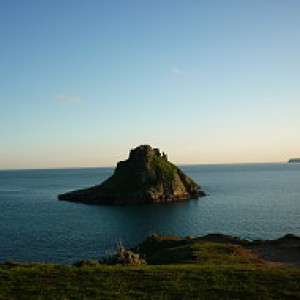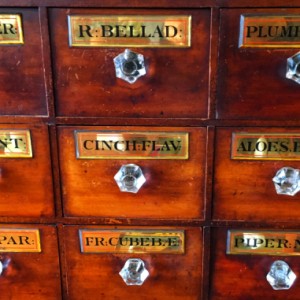The Pharmacy Cafe, Newton Abbot
The cafe is a splendid place where we had lunch today. It still has all the drawers and fittings - see +. The history below is from its website.
It was the Pharmaceutical Chemist Shop of Mr. John Henry Bibbings (1852 - 1942.) Newton's oldest tradesman. The son of an East Street Blacksmith, he was apprenticed to Hinton Lake, Chemist in Exeter, and after passing numerous examination his father set him up in business in this shop in 1877. Mr. Bibbings is recorded to have won a silver medal for his Herbarium in 1873 (a reference collection of pressed medicinal plants.) At this time the vast majority of drugs were still of plant origin and were imported from all over the world as bundles of roots, gourds of collected resin, strips of bark, or huge bales of herbage. These had to be verified as being of the correct medicinal species, and of a grade that would meet the stringent requirements of the British Pharmacopoeia updated in 1867 to bring uniformity to prescribed preparations across the Empire. Raw drugs probably arrived in Newton Abbot by train, and it would have been the Pharmacist's duty to test and check that these drugs were pure and not adulterated. The art of identifying the species of plant from pieces or powders is called 'Pharmacognosy', a skill that is exceptionally rare today.
With the introduction of medicines and large scale manufacture by the newly emerging pharmaceutical companies such as Bayer, Doctors slowly moved away from prescribing the herb-derivatives as research demonstrated a quicker-fix from these new discoveries. The world moved into a brave new century, and with it came the shop that we see today.
Remarkably the Honduras Mahogany fittings have weathered three serious town floods, wartime bombing raids and a fashion for refits, remaining much as they would have been when the shop first opened, the drugs run consists of no less than 117 small drawers, and the labels record in pharmaceutical Latin the names of drugs popularly used at the time. The mosaic is thought to have been laid by italian craftsmen, although the chandelier has only been in the residence since the 1980's! In the early days, it was important to keep the shop as cool and dark as possible to keep the drugs in good condition. The metal frieze around the top of the window would have let in a fresh air, and the windows themselves would have been boxed in by bevelled mirror panel, which must have created a stunning display of light amongst the gloomy Victorian windows of Queen Street. The door housed a bright-cut glass panel which read 'Prescriptions Accurately Dispensed.' The stained glass window is of particular interest, bearing amongst other symbols, the Caduceus (ascension of knowledge.) According to alchemical lore, Mercury messenger of the gods cast his staff between the two feuding serpent, which coiled around it forming the symbol of opposing forces held in balance. The 'healing hands' have also been long associated with the medicinal arts. Minor alterations were appaently made in 1897, there is no detail of what, but it could have been the addition of a fine set of York Glass Company 'shop rounds' which will be remembered by older Newtonians, over 200 uniform bottles.
Several large display bottles were filled with coloured water and displayed in the window, these bore the names of Mr Bibbings' famous perfumes The 'Devonia Violets' and the 'Bradley Woods Bouquet' which an advert from 1904 claims that this perfume lasts longer than any other scent, giving off whole volumes of enchanting odours even after repeated washing! Mr Bibbings used his knowledge of Botany to create his perfumes and is reputed to have personally set out for Grasse in southern France, armed with a pouch of gold sovereigns with which to purchase some of the precious essential oils distilled there. The mews of buildings behind the shop were once a thriving long store and laboratory, where drugs were stored and reduced, rendered and percolated ground, macerated and pressed There are few who can remember the shop under the management of J.H.Bibbings he passed away in 1942 and was succeeded by his son Arthur who was a noted local photographer.


Comments
Sign in or get an account to comment.


